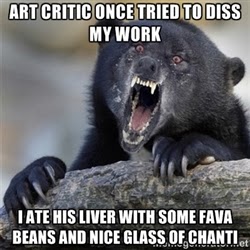I’ve been talking with friends and artists a lot lately and this topic keeps coming up. There have been many blog posts about how to give criticism (see my Guide to Criticism), but how does one receive criticism? Why should we? Is there a right or wrong way to take it? Better yet, is taking criticism essential for being a creative professional?
I remember the very first negative criticism I received way back in the days of Elfwood, where I housed my first online gallery ever. (You can see my old crappy Elfwood galleries here that I’ve left up for nostalgia’s sake). Sharing art there was the first time I ever received any kind of negative criticism concerning my art.
My young artist ego was shattered by the brutal honesty of some people who weren’t shy about telling me a piece was ugly or not well done. It was only later that I realized that most of these comments were not valid criticism, they were abusive and destructive. Some of their comments were honest about the piece’s effect on them, but hardly any solutions were provided to fix what might have been wrong with the piece. Frustration and self-doubt ensued! Silly, I know, but back then I was way more sensitive than I am now many years later.
Therein lies the first lesson we must learn as budding artists about criticism. You must become an expert at separating destructive criticism from constructive criticism and judging the validity of the critic. Not all critics mean well and some just want to troll you while others are honest but have no idea how to describe a solution to help you. The former should be ignored while the latter can help you to think about a piece in ways you may not have before and should be accepted as an opportunity to delve deeper into a new perspective.
I had far better luck bringing my work into a Circle of Trust formed of artist friends who were not afraid to be honest, but who could also provide constructive solutions to the problems in my work. I encourage young artists to do the same, especially during that tender beginning of your art career where a single bout of negativity can be destructive to your potential.
Epilogue’s forums were my old critique stomping grounds. Lately, CGhub and CGsociety are pretty awesome sites with helpful communities. Despite the CG tag, they both allow traditionally painted pieces in addition to digital. Facebook Groups of artists are a good place to participate as well with a select set of skilled people who are more apt to give you constructive criticism. You can start your own group or join one of the many already in existence. Another idea is to start a mailing list exclusively for your Circle of Trust. Mailchimp is a good free solution for doing just that. Mailchimp also lets you keep multiple mailing lists.
But then what happens when you move into the work force? That’s certainly no place to have a thin skin or you won’t last long, especially on a project requiring multiple people on a team where you’re required to collaborate. If you can’t share ideas and take suggestions, your work will stagnate and you’ll become known as that person who is difficult to work with or produces sub-par work because you aren’t improving. Sure, maybe you can come to some conclusions on your own after a long while, but chances are you won’t or it will take you far longer than other artists who are more dedicated to sacrificing some ego for the sake of improvement. Other times, we are just unable to see the flaws in our own work because we’ve been staring at it too long! I’ve always found seeking outside critique to be a good medicine for the ‘This Feels Wrong, But Don’t Know How to Fix It’ syndrome.
The cold hard truth is you are only setting yourself up for frustration as a creative professional if you cannot take critique. Thicken that skin early on and you’ll have a far better time of it.
Of course, some days you are just a human being and criticism hurts! That’s the time you should step away from a piece and take a break from seeking critique for it. You most likely aren’t going to take it well while you’re frustrated. Come back the day after with a renewed sense of dedication to making the piece the best it can be, even if you have to change it! Don’t get caught in the trap of self-doubt that might come with an unsatisfactory piece. Change, grow, create! Chances are you’ll end up with a piece you love even more than you did at the beginning.
Do you all have Circles of Trust? Are they public critique groups anyone can join? Share in comments! One of the coolest things about working in the Arts is that nearly all of us rejoice at the chance to help other artists succeed.
